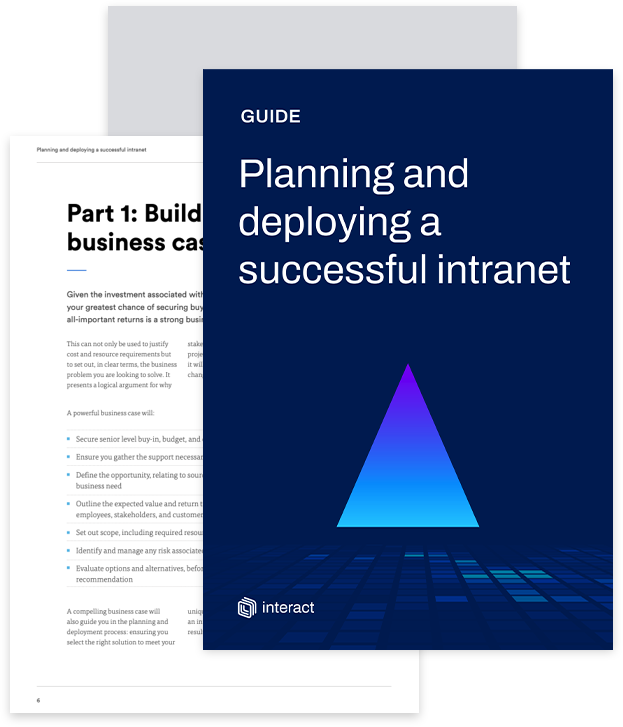How to lead an intranet, without causing (too many) office grumbles

Anyone with any experience of working in an office knows that it doesn’t take much to cause disgruntlement in the ranks. With so many different personalities, agendas, and priorities to take care of, how do you create something as transformative as an intranet build without encountering the usual moans from various members of staff?
Firstly, let’s get something out of the way. If you’re launching anything new, particularly something as big as an intranet, it’s virtually impossible to keep everyone happy. Think about the last time management made a change to the office kitchen use. Did it cause a grumble? Did senior level get at least one email of criticism? If yes, then you can only imagine the effect of introducing a digital workplace tool that will profoundly change the way people work may have.
However, many businesses have ushered in their intranets with great success, and with high engagement levels and user satisfaction. So in this blog, we’ll show you ways to at least minimize the grumbles, and allow you to get on with the important business of implementing and deploying your intranet in the most harmonious and workforce-friendly way possible.
Prepare for any potential onslaught
We’re not pre-empting an office tumult during the gestation period of your intranet, but it’s a good idea to see who or what could cause any discontent. This is best countered by briefing all members of your workforce on the plans. Explain what the intranet will achieve, why it is being introduced and what, if anything, will be asked of your workforce in the run-up to the launch. Most importantly, explain what benefits the intranet will have for the various departments within your organization.
Make a map of the roles and responsibilities

It’s important to have a visual map of the groups involved in your intranet, and who sits where within the hierarchy. This will also allow everyone to be vigilant of the roles they are expected to perform.
In a standard roles and responsibilities map for building an intranet, your organization will be divided into four tranches:
- The board
- The team
- The champions
- The workforce
The board is the group of people who are funding the intranet or who you need to be reporting to. Within the map, you will need to detail their needs and expectations and the ways they can measure the success of your project.
The team will be the select group of people who are managing the project. We’ll discuss building your intranet dream team in more depth shortly.
The champions are those within your organization who are giving you insights into the requirements of departments, locations or groups of workers. They will also act like the cheerleaders for the forthcoming intranet to peers.
The workforce is those people using your intranet and who will be directly affected by your intranet.
Build your intranet team
![]()
While there may be a dispersed group of individuals working on your intranet, it is recommended that you gather a central team to manage the intranet and make decisions. It by no means needs to be a dedicated team – most organizations will not have the resources to employ a full-time intranet manager, for example – your team needs to be able to balance their work on the intranet alongside their existing work.
The importance of getting the right people for this team is not to be underestimated. Choose people for their strengths, rather than what they do. Get it right and you avoid the common risks of project overrun, lack of accountability and poor governance.
As well as the initial build, you also need to be able to envision them taking on the following on a long-term basis:
- News and blogs
- In-depth knowledge of how to use the intranet
- Ability to gather new requirements
- Engaging stakeholders
- Encouraging collaboration
You and your team will be responsible for the planning, delivering and implementing of your intranet, as well as the ongoing management and its long-term success.
Recognize your champions
Your champions will not be part of your actual team, rather those people around your organization that you can rely on for suggestions, feedback, and enthusiasm for your intranet build.
These champions should have certain qualities: respect, empathy and an ability to connect with fellow workers. These champions will work as your network of influencers within your organization enthusing those they work closely with whom you may not be able to engage with as easily and will also work alongside you in providing recommendation and support.
To get them onboard, speak to them about the various pain points within their role, and create intranet-based solutions to those problems. With this approach to overcoming their many challenges, you stand a great chance of increased adoption across the company.
The same applies to getting buy-in from exec and middle management. Once you offer them the chance of solving many of their day-to-day issues, the more open they will be to offering resources for the project.
Get to know who your workforce is
With so many different characteristics, personalities and backgrounds in your organization, it’s never a good idea to lump people together into one category. These are the people who will be using your intranet, so it’s important to know who you’re making it for and realize when it comes to making something like an intranet, one size does not fit all.
However, it’s almost impossible to know every individual in a medium to large business – which is where the role of personas comes in. Personas allow you to break down your workforce and understand their access to technology, their challenges and why they will use the intranet.
The creation of your personas is based on a number of things – the role they are in, the challenges they face and their preferences. While personas are, to all extent and purposes, imaginary, they are based on reality and on the likes, dislikes, behaviors, and motivations of your real-life workforce.
You can gather this information through surveys, existing data, and workshops, but face-to-face conversations will also go a long way in getting a thorough understanding, as well as building up credibility with who you are, and what you are embarking on.
An illustration of a persona is this great example from NSPCC:

Communicating your agenda

No matter how minor the development, if people are kept in the dark about a new change, it increases the risk of widespread disapproval. When a big event like a new intranet occurs within an organization, it’s critical that the change management is handled correctly. You can do this in a number of ways:
Deliver your message with honesty and clarity
When it comes to updates on the project, be clear and honest. If there are any setbacks, communicate whether this pushes the launch date back. Don’t sugar coat anything you’re doing – use straightforward language to give an upfront message about the latest updates on your intranet and the plans going forward.
Give employees information on how your intranet will affect them
Get people’s attention by addressing how the changes will affect them. An intranet is a huge asset for a worker, allowing them to streamline processes and overcome many day-to-day challenges. Communicate the numerous advantages of having an intranet and its benefits to the worker.
Chart how the project will happen

It’s not only important to have a timeline of events for your intranet planning, it’s also very useful for communications with the workforce. Plot out the schedule with workers and show them the amount of time and effort going into the preparation of the intranet. Keeping them up to date with developments is a good way of getting input and inspiring ideas.
Tell employees what you need from them
If you need help from the workforce – beta testing, an ideas session, sounding boards etc, make sure you are clear on what you need through your various channels of communication.
Pick your source and channels
For all your messages consider your source. For example, for really important bulletins, you may need to call upon the services of the CEO or MD. A variety of channels is recommended – email, meetings, existing intranet and any other platforms you have within your organization.
Ultimately, the key to harmonious intranet planning is organization and communication. Having a well-structured plan and keeping your organization in the loop – whilst incorporating various departmental cheerleaders – should mean that you will be able to build and launch your intranet unscathed!
Click on the image below for more information on the best ways of deploying a successful intranet.

